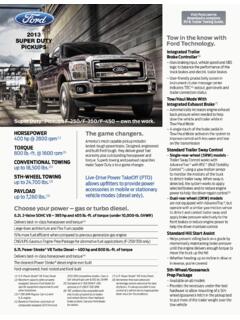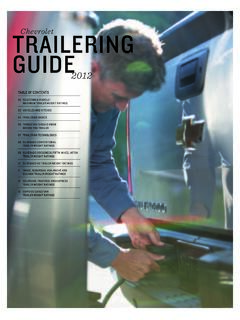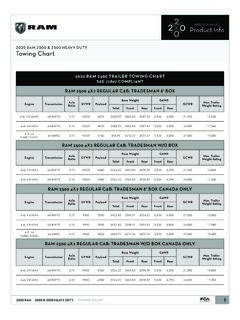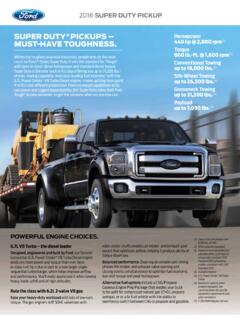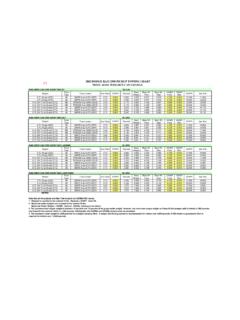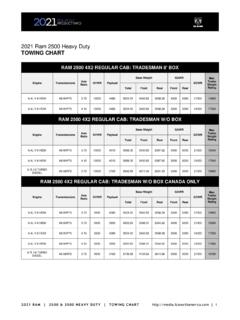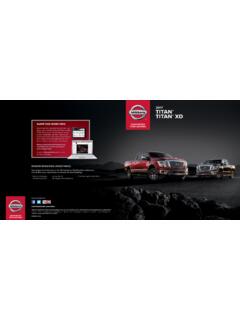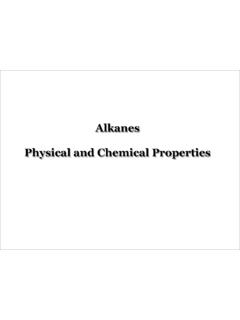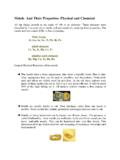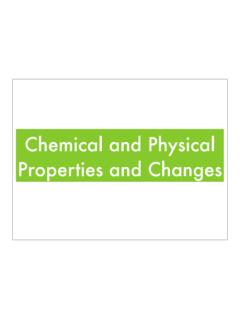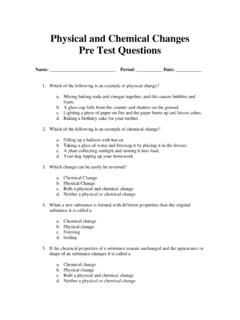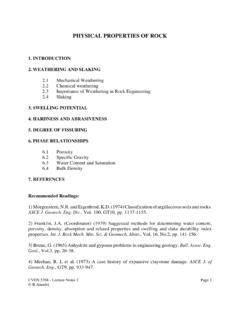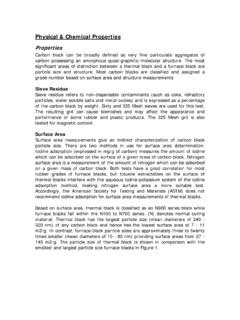Transcription of Using Physical and Chemical Properties to Manage …
1 Using Physical and Chemical Properties to Manage flammable Liquid Hazards Part 1-B: Physical & Chemical Properties of Selected Fuels SINGAPORE Suntec Tower Three 8 Temasek Blvd Singapore 038988 + WASHINGTON DC 4100 North Fairfax Drive, Suite 740, Arlington, VA 22203 1 SECTION 1: GENERAL INFORMATION Property/Information Hydrogen H2 (gas) CNG CH4 83-99%; C2H6 1-13% (gas) Propane C3 (liquid) Methanol CH3OH (liquid) Ethanol C2H5OH (liquid) Gasoline C4-C12 (liquid) No. 2 Diesel C8-C25 (liquid) B100 Biodiesel C12-C22 (liquid) DOT Number UN 1049 UN 1966 UN 1971 UN 1075 UN 1978 UN 1230 UN 1170 UN 1203 UN 1202 NA 1993 - DOT Hazard Class or Division flammable gas flammable gas flammable gas flammable liquid 3 flammable liquid 3 flammable liquid 3 flammable liquid 3 flammable liquid DOT Guide Number 22 17 22 28 26 27 128 - CAS Number 1333-74-0 74-82-8 74-98-6 65-56-1 64-17-5 8006-61-9 68476-34-6 67784-80-9 STCC Number 4905746 4905755 4905781 4909230 - 4908178 - - ICC, OSHA, NFPA Liquid Flammability Class - - - IB flammable liquid IB flammable liquid IB flammable liquid 2 combustible liquid 2 combustible liquid DOT Packing Group - - - PG II PG II PG II PG III PG III DOT Packaging (non-bulk/bulk)
2 302/302 302/302 304/314 202/242 202/242 202/242 203/242 203/242 Types of Shipping Containers Pressurized cylinders & tank cars Pressurized cylinders pressurized cylinders, tank trucks, tank cars, NON-BULK: 1-119 gal DOT PG-II performance- oriented containers BULK: tank cars, tank trucks NON-BULK: 1-119 gal DOT PG-II performance- oriented containers BULK: tank cars, tank trucks BULK: pipelines, tank cars, tank trucks BULK: pipelines, tank cars, tank trucks BULK: pipelines, tank cars, tank trucks Using Physical and Chemical Properties to Manage flammable Liquid Hazards Part 1-B: Physical & Chemical Properties of Selected Fuels SINGAPORE Suntec Tower Three 8 Temasek Blvd Singapore 038988 + WASHINGTON DC 4100 North Fairfax Drive, Suite 740, Arlington, VA 22203 2 SECTION 1: GENERAL INFORMATION (CONT.)
3 Property/Information Hydrogen H2 (gas) CNG CH4 83-99%; C2H6 1-13% (gas) Propane C3 (liquid) Methanol CH3OH (liquid) Ethanol C2H5OH (liquid) Gasoline C4-C12 (liquid) No. 2 Diesel C8-C25 (liquid) B100 Biodiesel C12-C22 (liquid) Shipping Container Hazards rupture, BLEVE: containers may fragment & rocket in fire rupture, BLEVE: containers may fragment & rocket in fire rupture, BLEVE: containers may fragment & rocket in fire rupture, BLEVE: containers may fragment & rocket in fire rupture, BLEVE: containers may fragment & rocket in fire rupture, BLEVE: containers may fragment & rocket in fire rupture, BLEVE: containers may fragment & rocket in fire rupture, BLEVE: containers may fragment & rocket in fire Special Fire Hazards blue flame invisible in daylight; flame flashes back from ignition source to leak point.
4 Accumulated vapor may explode if ignited in confined or in unconfined area yellow luminous flame visible in daylight; flame flashes back from ignition source to leak point; accumulated vapor may explode if ignited in confined area or deflagrate as a buoyant radiant fireball in unconfined area yellow luminous flame visible in daylight; flame flashes back from ignition source to leak point; accumulated vapor may explode if ignited in confined area or deflagrate as a non-buoyant radiant fire ball in unconfined area blue flame invisible in daylight; flame flashes back from ignition source to leak point; accumulated vapor may explode if ignited in confined area or deflagrate as a near- neutral-buoyancy radiant fire ball in unconfined poorly ventilated area blue flame invisible in daylight; flame flashes back from ignition source to leak point; accumulated vapor may explode if ignited in confined area, or deflagrate as a near-neutral-buoyancy fire ball in unconfined poorly ventilated area yellow luminous flame visible in daylight; flame flashes back from ignition source to leak point; accumulated vapor may explode if ignited in confined area or deflagrate as a non-buoyant radiant fire ball in unconfined area yellow luminous flame visible in daylight; dense black smoke yellow luminous flame visible in daylight.
5 Dense black smoke Using Physical and Chemical Properties to Manage flammable Liquid Hazards Part 1-B: Physical & Chemical Properties of Selected Fuels SINGAPORE Suntec Tower Three 8 Temasek Blvd Singapore 038988 + WASHINGTON DC 4100 North Fairfax Drive, Suite 740, Arlington, VA 22203 3 SECTION 1: GENERAL INFORMATION (CONT.) Property/Information Hydrogen H2 (gas) CNG CH4 83-99%; C2H6 1-13% (gas) Propane C3 (liquid) Methanol CH3OH (liquid) Ethanol C2H5OH (liquid) Gasoline C4-C12 (liquid) No. 2 Diesel C8-C25 (liquid) B100 Biodiesel C12-C22 (liquid) Other Information H2 gas release is very buoyant and invisible CNG gas release is buoyant and invisible, natural gas has characteristic odor liquid floats & boils on water; heavier-than-air visible vapor cloud liquid floats & mixes with water; near neutral vapor buoyancy liquid floats & mixes with water; near neutral vapor buoyancy liquid floats on water; high vapor pressure, expected to form negative buoyancy vapor cloud liquid floats on water; low vapor pressure, formation of vapor cloud not expected liquid floats on water.
6 Low vapor pressure, formation of vapor cloud not expected Molecular Weight (2) (2) (2) (1,2) (1,2) 100-105 (1,2) ~200 (1,2) ~292 (2) Chemical Composition Carbon (w/w%) 0 (2) 75 (2) 82 (2) (2) (2) 85-88 (2) 87 (2) 77 (2) Hydrogen (w/w%) 100 (2) 25 (2) 18 (2) (2) (2) 12-15 (2) 13 (2) 12 (2) Oxygen (w/w%) 0 (2) - - (2) (2) 0 0 (2) 11 (2) Using Physical and Chemical Properties to Manage flammable Liquid Hazards Part 1-B: Physical & Chemical Properties of Selected Fuels SINGAPORE Suntec Tower Three 8 Temasek Blvd Singapore 038988 + WASHINGTON DC 4100 North Fairfax Drive, Suite 740, Arlington, VA 22203 4 SECTION 2: LIQUID Properties Property/Information Hydrogen H2 (gas) CNG CH4 83-99%; C2H6 1-13% (gas) Propane C3 (liquid) Methanol CH3OH (liquid) Ethanol C2H5OH (liquid) Gasoline C4-C12 (liquid) No.
7 2 Diesel C8-C25 (liquid) B100 Biodiesel C12-C22 (liquid) Freezing Point Temp. (oF) -435 (2) -296 (2) (2) (1,2) (1,2) -40 (1,2) -40 to -30 (1,2) 26-66 (2) Specific Gravity (@ 60 oF/60 oF) (2) (2) (2) (1) (1) (2) (2) (2) Density (lb/gal @ 60 oF) - (2) (2) (1,2) (1,2) (1,2) (1) (2) (2) Viscosity @ -4 oF (centipoises / mm2/s) - - - (1) (2) (1) (2) (1) - (2) (1) - (2) - @ 68 oF (centipoises / mm2/s) - - - (1) (2) (1) (2) (1) (2) (1) (2) - @ 104 oF (centipoises / mm2/s) - - - - - - - - - - - - - (2) (2) Specific Heat (Cp, Btu/lb-oF) - - - (1,2) (1,2) (1,2) (1,2) - Thermal Conductivity (Btu/hr-ft-oF) (4) (4) (6) (3) (3) (4) (5,6) (7) Coefficient of Thermal Volume Expansion (@ 60 oF & 1 atm) - - - (1) (1) (1)
8 (1) - Electrical Conductivity Neat or without additives - - - x 107 pS/m (1,26, 32) x 105 pS/m (1,26, 32) 25 pS/m (7) 5 pS/m (7) - Using Physical and Chemical Properties to Manage flammable Liquid Hazards Part 1-B: Physical & Chemical Properties of Selected Fuels SINGAPORE Suntec Tower Three 8 Temasek Blvd Singapore 038988 + WASHINGTON DC 4100 North Fairfax Drive, Suite 740, Arlington, VA 22203 5 SECTION 2: LIQUID Properties (CONT.) Property/Information Hydrogen H2 (gas) CNG CH4 83-99%; C2H6 1-13% (gas) Propane C3 (liquid) Methanol CH3OH (liquid) Ethanol C2H5OH (liquid) Gasoline C4-C12 (liquid) No. 2 Diesel C8-C25 (liquid) B100 Biodiesel C12-C22 (liquid) Electrical Conductivity Cont. Industrial use - - - 30 S/m (28) - - - - Fuel specification - - - < 1000 S/m (32) < 500 S/m(27) - < 250 pS/m(28) - Latent Heat of Vaporization (Btu/gal @ 60 oF) - - 775 (2) 3,340 (1,2) 2,378 (1,2) 900 (1,2) 710 (1,2) - (Btu/lb @ 60 oF) (2) 219 (2) (2) 506 (1,2) 396 (1,2) 150 (1,2) 100 (1,2) - Heating Value (a) Lower [liquid fuel combusted to water as vapor] (Btu/gal @ 60 oF)(1) - - - 84250 (2) 56800 (1) 57250 (2) 76000 (1) 76330 (2) 109000-119000 (1) 116090 (2) 126000-130800 (1) 128450 (2) - 119,550 (2) Lower [liquid fuel combusted to water as vapor] (Btu/lb) - 52217 (2) - 20263 (2) - 19900 (2) 8570 (1) 8637 (2) 11500 (1) 11585 (2) 18000-19000 (1) 18676 (2) 18000-19000 (1) 18394 (2) 16,131 (2)
9 Higher [liquid fuel combusted to liquid water] (Btu/gal) - - 91420 (2) 65200 (2) 84530 (2) 124340 (2) 137380 (2) 127960 (2) Higher [liquid fuel combusted to liquid water] (Btu/lb) - 59806 (2) - 22449 (2) 21594 (2) 9750 (1) 9837 (2) 12800 (1) 12830 (2) 18800-20400 (1) 20004 (2) 19200-20000 (1) 19673 (2) 17266 (2) a The higher heating value (HHV) and heat of combustion are cited for completeness only. No vehicles currently in use or under development for future use have engines capable of recovering heat of condensation from water of combustion. Use the lower heating value (LHV) for practical comparison between fuels which combust accidentally as a result of a spill or containment failure. Using Physical and Chemical Properties to Manage flammable Liquid Hazards Part 1-B: Physical & Chemical Properties of Selected Fuels SINGAPORE Suntec Tower Three 8 Temasek Blvd Singapore 038988 + WASHINGTON DC 4100 North Fairfax Drive, Suite 740, Arlington, VA 22203 6 SECTION 2: LIQUID Properties (CONT.)
10 Property/Information Hydrogen H2 (gas) CNG CH4 83-99%; C2H6 1-13% (gas) Propane C3 (liquid) Methanol CH3OH (liquid) Ethanol C2H5OH (liquid) Gasoline C4-C12 (liquid) No. 2 Diesel C8-C25 (liquid) B100 Biodiesel C12-C22 (liquid) Heat of Combustion [ Hc0] [liquid fuel combusted to liquid water] (Btu/lb) 60000 (30,31) 61000 (34) 23000 (30,31) 21500 (30,31) 21000 (34) 9900 (30,31) 9378 (35) 12900 (30,31) 12000 (34) 12764 (36) 20000 (30,31, 34) 20700 (30,31) 19300 (34) 18,145 (30,31) Equilibrium Vapor Pressure Reid [RVP] (psi @ 100 oF) - 2400 (2) 208 (2) (1,2) (1,2) 8 15 (1,2) < (1,2) < (2) True Vapor Pressure [TVP] (mm Hg @ 68 oF) - - (13) 92 (10) 104 (11) 43 (9) 258-775 (15) (@ 100 oF) (14) - Boiling Pt. Temperature (oF) -423 (2) (2) -44 (2) 149 (1,2) 172 (1,2) 80 437 (2) 356 644 (2) 599 662 (2) Water Solubility @ 70 oF Fuel in Water (v/v %) - Negligible (2) Negligible (2) 100 (1,2) 100 (1,2) Negligible (1,2) Negligible (1,2) - Water in Fuel (v/v %) - - - 100 (1,2) 100 (1,2) Negligible (1,2) Negligible (1,2) - Vapor Specific Heat (Btu/lb/oF) (16) (16) (16) (18) (19) (33) (b) - - b This value of Cp for an ideal gas at STP (60 oF and 1 atm of pressure) uses the heat capacity of heptane (C7H16) as a surrogate for gasoline vapor.

